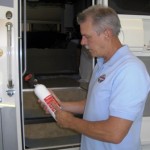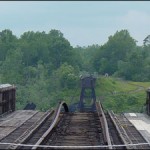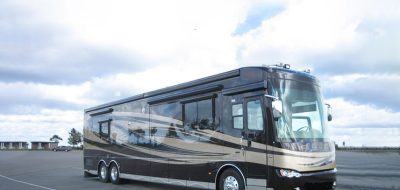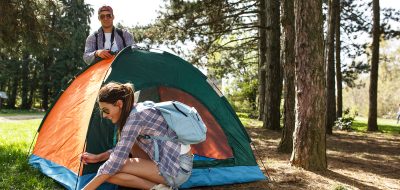 We recently took our RV out for the first camping trip of the season. I prepped the RV for the trip by making the normal checks I make each spring. During these checks I found some small problems that I was able to correct right away, and I found at least one bigger problem that would require a visit to the dealership when we returned back home.
We recently took our RV out for the first camping trip of the season. I prepped the RV for the trip by making the normal checks I make each spring. During these checks I found some small problems that I was able to correct right away, and I found at least one bigger problem that would require a visit to the dealership when we returned back home.
I think most RV owners go through some type of routine checks prior to taking their RV out for the first time each year. You check the tires, lights, appliances, LP gas and water system. But then a thought occurred to me, I wonder how many people remember to check all of the safety devices on the RV at the beginning of a new camping season?
If the RV sat in storage for several months there is a good chance that batteries are dead in things like the smoke alarm and carbon monoxide detector and the fire extinguisher could probably use some attention too. If the time ever comes that you need these items you’ll be glad they are in proper operating condition.
Here is a short list of some RV safety related items to check, taken from our RV Safety Features, Tips & Tricks DVD
LP gas leak detector:
In its natural state LP Gas is odorless, colorless & tasteless. An odorant is added to assist you in detecting leaks. If you are not familiar with the odor of LP gas, the next time you go to a qualified fill station ask the attendant to let you smell it. Most people describe the smell as being similar to rotten eggs, or as having a garlic type odor.
RV’s come equipped with LP gas leak detectors to assist in leak detection. LP gas leak detectors are located close to floor level because LP gas is heavier than air. Before each trip make sure the LP gas leak detector is operating properly.
If you ever smell LP gas or if the leak detector audible alarm goes off you should:
*Extinguish any open flames & pilot lights.
- Do not smoke or touch electrical switches.
- Evacuate the RV & turn off the main gas supply.
- Leave the door open & do not return until the odor clears.
- Have the system checked out by a qualified technician before using it again.
You can also test the system for leaks by using an approved LP gas leak detector solution. With the main gas supply turned on (but nothing lit) swab all LP gas fittings and connections with a non-corrosive bubble solution, available at your local RV dealership. If bubbles are noticeable at any fittings or connections turn the main gas supply off and have the leak repaired by an authorized service center. If you attempt to tighten the fitting yourself always use a back up wrench to avoid damage to the threads, fittings or other components. Recheck for leaks after tightening any fittings.
Caution: Never check for LP gas leaks using an open flame. If you don’t feel comfortable working around LP gas, have these checks performed by an authorized RV service center.
You should take your RV to a qualified RV service center annually to have the LP gas system checked. RV technicians have the equipment required to test the LP gas system for leaks and to test and adjust the LP gas operating pressure so the appliances will operate properly.
Fire Extinguishers:
There are many different types and sizes of fire extinguishers, but for the most part they work the same way. Teach everybody to remember the word PASS. This is an easy way to remember how to use a fire extinguisher, especially during an emergency. PASS stands for Pull, Aim, Squeeze and Sweep.
P– Pull the pin located at the top of the fire extinguisher.
A– Aim the nozzle at the base of the fire, not at the flames.
S- Squeeze the handle or trigger, standing approximately 8 feet away from the fire. Release the handle if you want it to stop.
S– Sweep the nozzle side to side at the base of the fire until it is out. Observe the fire to make sure it does not re-ignite.
Note: Check the individual fire extinguisher for the distance you should stand from the fire. Different extinguishing agents require different distances.
Fire Extinguisher Maintenance:
Inspect your fire extinguishers every 30 days & before each trip. Look to see if the arrow is pointing in the green area in the sight gauge. If it reads empty or needs charging replace it or have it recharged immediately. Inspect all components of the extinguisher to make sure it is in proper operating condition. Inspect the safety pin, handle or trigger, sight gauge indicator, inspection tag, hose or nozzle, tank, and labeling. Every month you should turn dry powder extinguishers upside down, tap on the bottom of the extinguisher and shake it so the powder that settled on the bottom is released. If the powder is packed in the bottom of the extinguisher it may not discharge properly, or at all, when you need it.
If a Fire Starts in or around the RV:
- Get everybody out of the RV and away from the fire safely.
- Have somebody call 911 for help.
- Most importantly, do not risk your personal safety. If you cannot extinguish the fire in the first minute or so let the professionals handle it.
Note: In the event of a fire always remember you save lives first & property second!
Smoke Alarms:
- RV’s come equipped with a smoke alarm. In less than 30 seconds a small flame can turn into a major fire & within a minute the RV can be filled completely with smoke. A smoke alarm can save lives. You may want to install additional smoke alarms in your RV.
- Test smoke alarms monthly & before each trip.
- Replace the battery in smoke alarms twice a year when you change your clocks for daylight savings time.
- Instruct everybody in the RV on an emergency escape plan in the event of a fire.
Carbon Monoxide (CO) Detector:
Carbon Monoxide Gas is invisible, odorless, and deadly. Carbon Monoxide is created when any fuel is burned; this includes gasoline, propane, natural gas, wood, & coal. It is extremely serious when combustion by-products are not vented outside. Carbon Monoxide is the number one cause of poisoning deaths in the United States each year. Let’s look at what we can do to prevent the danger of carbon monoxide in our RV.
As for RV’s, Carbon Monoxide Gas usually results from:
*Exhaust leaks from either a vehicle engine or a generator.
- Improper use of portable gas powered heaters.
- Someone else’s vehicle or generator when camping in close quarters.
If your RV doesn’t have a carbon monoxide detector you need to purchase a battery operated carbon monoxide detector designed for use in RV’s. Test the carbon monoxide detector every time you use the RV. Replace the carbon monoxide detector batteries when you change clocks for daylight savings time.
Here are some more important notes about Carbon Monoxide:
- Inspect the generator exhaust system before using the generator, every time.
- Avoid leaving windows down and roof vents open when in close proximity to vehicle and/or generator exhaust.
- Follow all directions and safety cautions and warnings when operating gas powered heaters.
- If you use a portable generator direct the exhaust away from the camping area.
- Never use the range burners or oven to heat the RV!
- When cooking with the range burners use the range fan & always leave a window cracked open for fresh air and ventilation.
Learn how to recognize Carbon Monoxide Symptoms: symptoms include
- Dizziness
- Vomiting
- Nausea
- Muscular twitching
- Intense headache
- Throbbing in the temples
- Weakness and sleepiness
- Inability to think coherently
If you or anyone else experiences any of these symptoms get to fresh air immediately. If the symptoms persist seek medical attention.
Shut the vehicle or generator down and do not operate it until it has been inspected and repaired by a professional.
View our carbon monoxide video clip
Emergency Escape Plan:
Last but not least we want to discuss a topic many RVers don’t think about, an emergency escape plan. What do you do in the event of an emergency and everybody has to get out of the RV quickly and in an orderly fashion. The National Fire Protection agency requires that RV’s have emergency escape windows. Make sure everybody knows where the escape window is located and how to use it. It’s a good idea to practice using it so you are familiar with how to get out of the RV in case of an emergency. You should have an emergency escape plan for the front of the RV and the rear of the RV.
- Time is your biggest enemy if there is a fire. It only takes one minute for smoke to fill the RV.
- Design an escape plan specific to the needs of the individuals in the RV.
- Sketch your plan on paper and indicate which windows and doors can be used to escape. Review the plan with everybody.
- Make sure everybody knows where the emergency escape window is located and how to use it.
- Make sure everybody knows how to use window and door latches before there is an emergency.
- Practice your escape plan so everybody is familiar with how to get out of the RV in case of an emergency.
- Designate a meeting place outside where everybody will meet.
Happy Camping & Be Safe,
Mark Polk
RV Education 101
RV University







tssfdtym
luybkA , [url=http://oklyvhhbzqve.com/]oklyvhhbzqve[/url], [link=http://muwtmzrmtodi.com/]muwtmzrmtodi[/link], http://yzgrqeatnjhg.com/
qyqrqphxuzy
mDVCEi mguupxstgkcq
hthvrv
50su0s , [url=http://fdqhhecuhgil.com/]fdqhhecuhgil[/url], [link=http://rdntzwvdskwp.com/]rdntzwvdskwp[/link], http://ybirlfrjmtcg.com/
xiolqn
41RYPq thynywonbnnf
Klajdi
People are so hypocritical in today’s steicoy. When the government suggests something, we all complain about it. But then when something happens to us or our families we are the first to say they should pass a law mandating something similar to this one(Carbon Monoxide Detector) so that nothing bad happens again. GET WITH THE PROGRAM. This is about showing you care about your family and there safety. Carbon Monoxide is a silent killer, and the only way to protect you and your family is to have a detector.
Fred
Mark, As part of my spring maintenance, I not only check the propellant level in my fire extinguisher, but invert it and shake it vigorously. During the season, the vibration of drivivg my RV causes the chemical to pack solid in the bottom and it may not flow freely during use. I do this periodically throughout the season. It certainly cant hurt.
Thanks for the great article.
Fred and Gwen
Rio Rancho, NM
Bev Stones
Without a doubt CO Alarms are a must for all RV’s and all Homes everywhere.
BUT … what people do not know is that by pressing the test button on the CO Alarm only tests the battery life to the alarm bell. The test button does NOT test the sensor which is the most life critical component on the CO Alarm.
You may of pressed your test button – just like the manufacturers say to do in their instructions. You will then be satisfied that you are covered. YOU ARE NOT !!
All CO Alarms need to be tested with a source of external Test Gas – this tests the sensor which in turn tests the bell and the battery.
It is so safe and easy to use. You can then be totally satisfied that your CO Alarm is in full working order.
I have read so many news stories that people have tested their CO Alarm and even changed the batteries (mostly for their kids at College) on the Friday and by Monday they have been found dead by CO Poisoning as the sensor was not functioning.
It is without doubt that everyone should install CO Alarms as they have proved to be a life saving product – Detectagas CO Alarm Test Kit just makes that product a lot stronger and gives more peace of mind to the reliability and functionality to the user.
The product is out there and available !! Lets keep everyone safe and alive.